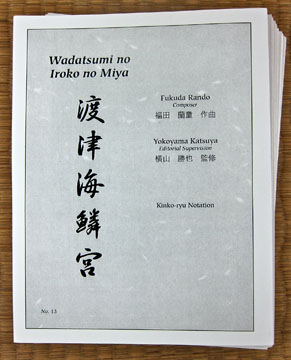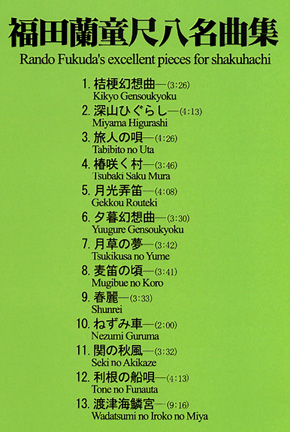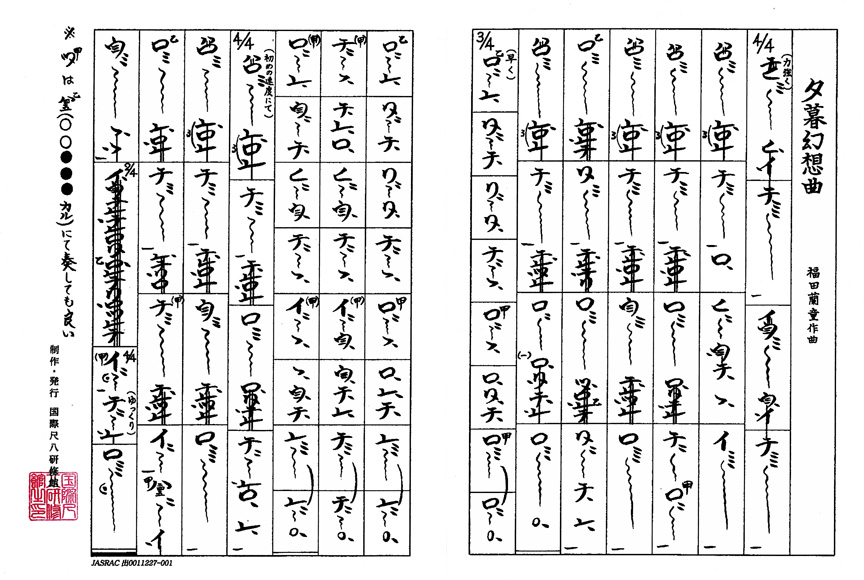
Rando Fukuda / 福田 蘭童
SHAKUHACHI SHEET MUSIC
Modern Compositions
Solo, Duet, Trio & Quartet for Shakuhachi, Koto, Piano & Voice
(Kinko-ryu & 5 Line Staff Notation)
|
Rando Fukuda / 福田 蘭童 SHAKUHACHI SHEET MUSIC Modern Compositions (Kinko-ryu & 5 Line Staff Notation) |
Rando Fukuda studied shakuhachi for over eight years with Sekiguchi Getsudo, and later with Mizuno Ryodo. During this time, he felt a strong need to familiarize himself with Western music theory as well, so enrolled in music school in Tokyo where he studied piano with Miyazaki Kingetsu and violin with Takashina Tetsuo. From hereon in, Fukuda's pursuit of academics was overshadowed by an intensive study of music that lasted for the remainder of his life. Of historical interest is the fact that Fukuda's only shakuhachi students were later to be became two icons of the instrument. Ranpo Yokoyama was Fukuda's uchi deishi ("live-in apprentice"), followed by his son, one of the great masters of the post World War II generation, Katsuya Yokoyama. It was via this transmission, as is customary, that Ranpo 蘭畝 received his shakuhachi name, one kanji of which was taken from that of his teacher, Rando 蘭童. Rando Fukuda was a remarkable multi-talented individual. Founder of the Asuma-ryu sect of shakuhachi, he was a prolific composer and performer of both traditional and contemporary music. Along with playing solo honkyoku and the ensemble form of sankyoku, he composed numerous radio and movie themes. In addition, he was an avid writer, publishing books related to his passions for culinary arts and fishing. Fukuda's legacy is embodied in the compositions presented here. Many thanks to his grandson Tetsuya Ishibashi and directors of theKokusai Shakuhachi Kenshukan (International Shakuhachi Training Center) for allowing Tai Hei Shakuhachi to publish this very special resource for shakuhachi players and enthusiast outside of Japan and around the world. Amongst the pieces in this collection is "Wadatsumi no Iroko no Miya" that Fukuda dedicated to the memory of his father at a ceremony in honoring Shigeru Aoki's work many years after his death. This composition was inspired by the Aoki's masterpiece "Paradise Under the Sea". |
 |
KATSUYA YOKOYAMA PLAYS RANDO FUKUDA:
Rando Fukuda and Katsuya Yokoyama For complete information about this DVD, click here. |
Video Previews
Sheet Music of the Pieces Performed on this DVD
Item# |
Listen |
Title |
曲名 |
Pages |
Notation |
Instrumentation |
| RF-1 | * |
Kikyo Gensoukyoku | 桔梗幻想曲 | 2 |
Kinko-ryu | Solo Shakuhachi |
| RF-2 | Miyama Higurashi | 深山ひぐらし | 2 |
Kinko-ryu | Solo Shakuhachi | |
| RF-3 | * |
Tabibito no Uta | 旅人の唄 | 2 |
Kinko-ryu | Solo Shakuhachi |
| RF-4a/b | Tsubaki Saku Mura | 椿咲く | 2/3 |
Kinko-ryu & 5 Line Staff | Duet-Shakuhachi & Koto/Piano | |
| RF-5a/b | Gekkou Routeki | 月光弄笛 | 2/3 |
Kinko-ryu & 5 Line Staff | Duet-Shakuhachi & Koto/Piano | |
| RF-6a/b | * |
Yuugure Gensoukyoku | 夕暮幻想曲 | 2/4 |
Kinko-ryu & 5 Line Staff | Duet-Shakuhachi & Koto/Piano |
| RF-7a/b | * |
Tsukikusa no Yume | 月草の夢 | 2/4 |
Kinko-ryu & 5 Line Staff | Duet-Shakuhachi & Koto/Piano |
| RF-8a/b | * |
Mugibue no Koro | 麦笛の頃 | 3/6 |
Kinko-ryu & 5 Line Staff | Duet-Shakuhachi & Koto/Piano |
| RF-9a/b | * |
Shunrei | 春麗 | 2/5 |
Kinko-ryu & 5 Line Staff | Duet-Shakuhachi & Koto/Piano |
| RF-10 | Nezumi Guruma | ねずみ車 | 2 |
Kinko-ryu | Quartet - 4 1.8' Shakuhachi | |
| RF-11 | Seki no Akikaze | 関の秋風 | 2 |
Kinko-ryu | Trio - 3 1.8' Shakuhachi | |
| RF-12 | Tone no Funauta | 利根の舟歌 | 3 |
Kinko-ryu | Duet: 2 1.8' Shakuhachi | |
| RF-13 | Wadatsumi no Iroko no Miya | 渡津海鱗宮 | 12 |
Kinko-ryu | Trio: 2 1.8' & 2.8' Shakuhachi |
Other Compositions by Rando Fukuda
Item # |
Listen |
Title |
曲名 |
Pages |
Notation |
Instrumentation |
| RF-14a/b | * |
Seiyakyoku | 星夜曲 | 2/4 |
Kinko-ryu & 5 Line Staff | Duet: Shakuhachi & Koto/Piano |
| RF-15 | * |
Tanima no Seseragi | 谷間のせせらぎ | 2 |
Kinko-ryu | Solo Shakuhachi |
| RF-16 | Komoriuta | 子守唄 | 2 |
Kinko-ryu | Solo Shakuhachi | |
| RF-17 | Otomegokoro | 乙女心 | 2 |
Kinko-ryu | Solo Shakuhachi | |
| RF-18 | * |
Mushi Tsukiyo | 蟲月夜 | 2 |
Kinko-ryu | Solo Shakuhachi |
| RF-19 | Shunshouen | 春宵怨 | 4 |
Kinko-ryu | Solo Shakuhachi | |
| RF-20 | * |
Fuefuki Doji / Beni Kujaku / Kaze no Koroku | 笛吹き童子/紅孔雀/風の小六 | 2 |
Kinko-ryu | Solo Shakuhachi |
| RF-21 | Ake no Kane | 明けの鐘 | 3 |
5 Line Staff | Trio: Shakuhachi, Koto/Piano & Voice | |
| RF-22 | Nagekedo Hito wa | 嘆けど人は | 6 |
5 Line Staff | Trio: Shakuhachi, Koto/Piano & Voice |
Kinko-ryu & 5-Line Staff notation (marked a/b) are published and sold as separate scores. 22 compositions / 29 scores in all.
Available individually or in sets. Sets are bound in a hard cover 3-ring binder notebook with storage pouches inside.
Music Notation for Yugure Gensoukyoku

 |
Wadatsumi no Iroko no Miya / 渡津海鱗宮
Performed by Teruo Furuay, Kazushi Matama & Kaoru Kakizakai
at the World Shakuhachi Festival in Sydney, Australia (2008)
| Price of Scores & DVD | Ordering Information |
Learn more about |